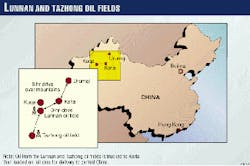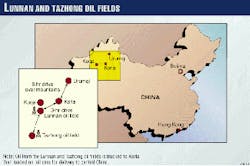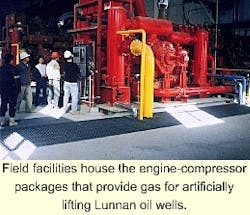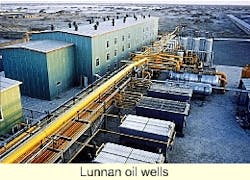China National Petroleum Co. (CNPC) opted for low-emission compressor packages for gas lifting oil in the Lunnan field in the remote Tarim basin of Western China (Fig. 1).
China estimates that the Tarim basin (Fig. 1) contains about 18.45 billion tons of oil and gas resources in scattered accumulations. It proved out some of these resources several decades ago but has only recently begun to exploit them.
Nestled between the Tien Shan and Kulun Shan mountain ranges, the Tarim basin is the second largest desert in the world, roughly the size of France (560,000 sq km). It has a harsh climate with temperatures in the summer reaching 47° C. (116° F.) and in the winter dropping to -34° C. (-30° F.).
The Chinese aptly dub the main road leading into the territory "The road of hope," because it will be the lifeline to the country's future petroleum needs.
Between 1995 and 1997, production from Western China increased nearly 30%, reaching 22.28 million tons.
Engine-compressor packages
Lunnan is one of the largest oil fields in the Tarim basin. To produce the field, CNPC installed a closed-loop, gas-reinjection system that provides gas for artifically lifting the oil from the wells.
The system includes five electronically controlled Caterpillar G3608 natural gas engines, each rated to provide 2,220 hp at 1,000 rpm and four-stage HOS Dresser-Rand compressors (Fig. 2). - Field facilities (left) house the engine-compressor packages (right) that provide gas for artificially lifting Lunnan oil wells (Fig. 2).
The Caterpillar engines run directly from gas supplied by the compressors.
One challenge at the site was that the gas quality at the Lunnan field was substandard, varying from a methane number of 52 to near 40. To compensate for this variance, the engines required advanced electronic controls for monitoring the gas quality and adjusting the timing and air-fuel ratio.
The gas-engine control module (GECM) contains detonation sensors that, within one stroke (1
When the cylinders fire irregularly, the engine will detonate. An automatic safety control will shut off the engines in the event that the detonation persists.
The GECM also controls the optimum air-fuel ratio to maintain full-power operation. An air choke downstream of the turbocharger will allow more or less air into the combustion chambers to maximize engine efficiency.
An RS-232 modem port connects the GECM remotely to a monitoring station a few hundred yards away. Remote monitoring provides the operation a way to control virtually all facets of the production process at one central location.
Emissions
CNPC specified that the engines had to produce the lowest possible emissions. Even in the middle of the second largest desert in the world, the Chinese government considered the health of its workers and anticipated future air pollution treaties.
The electronic controls and other design features should allow the engine-compressor package to remain emission compliant for the lifetime of the field.
Without the electronic controls, the engines would suffer from irregular combustion. The internal wear and tear created would not only significantly reduce the engine's life expectancy, but also increase the level of NOx (nitrous oxide) emissions released to the atmosphere, an important issue for CNPC.
Caterpillar rates each engine at 0.70 g/bhp/hr, with the lean-burn emissions control being effective down to 50% load.
Servicing
Another concern for CNPC was the serviceability of the packages in the Tarim basin. The project directors wanted extensive on site testing and personnel training, immediate product support, and a considerable warranty.
The Caterpillar product support center in Beijing provided two technicians to install and test the engine-compressor packages and to remain on site 1 year for personnel training and product support. An aggressive installation agreement allowed only 5 days for installing each engine-compressor package.
Because of the remote location of the field, 2 years of spare parts were supplied, along with a 1-year, Caterpillar-managed, field follow-up program.
The Author
Gordon Gerber is new product introduction manager for Caterpillar Inc., Lafayette, Ind. Gerber has responsibility for Caterpillar's line of gaseous-fueled engines including natural gas, biogas, and petroleum engine applications. Previously, his work included sales and service support for the Far East, including China.






